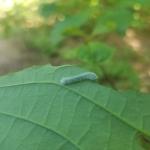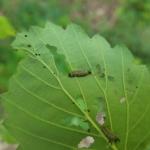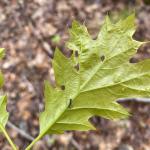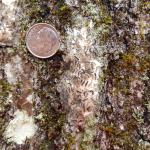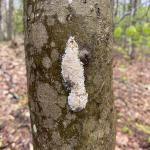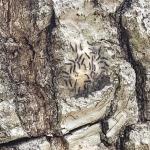UMass Extension's Landscape Message is an educational newsletter intended to inform and guide Massachusetts Green Industry professionals in the management of our collective landscape. Detailed reports from scouts and Extension specialists on growing conditions, pest activity, and cultural practices for the management of woody ornamentals, trees, and turf are regular features. The following issue has been updated to provide timely management information and the latest regional news and environmental data.
Thanks for your continuing interest! To receive immediate notification when the next Landscape Message update is posted, be sure to join our e-mail list
To read individual sections of the message, click on the section headings below to expand the content:
Scouting Information by Region
Environmental Data
The following data was collected on or about May 24, 2023. Total accumulated growing degree days (GDD) represent the heating units above a 50ºF baseline temperature collected via regional NEWA stations (http://newa.cornell.edu) for the 2023 calendar year. This information is intended for use as a guide for monitoring the developmental stages of pests in your location and planning management strategies accordingly.
|
MA Region/Location |
2023 Growing Degree Days |
Soil Temp |
Precipitation |
Time/Date of Readings |
||
| Gain since last report |
2023 total |
Sun |
Shade |
|||
|
CAPE |
64 |
297 |
67 |
58 |
0.00 |
12:00 PM 5/31/2023 |
|
SOUTHEAST |
45 |
276 |
74 |
58 |
0.00 |
3:00 PM 5/31/2023 |
|
NORTH SHORE |
49 |
261 |
60 |
52 |
0.07 |
10:00 AM 5/31/23 |
|
EAST |
73 |
356 |
73 |
62 |
0.10 |
4:00 PM 5/31/2023 |
|
METRO |
64 |
304 |
59 |
53 |
0.16 |
5:45 AM 5/31/2023 |
|
CENTRAL |
73 |
345 |
66 |
59 |
0.21 |
4:42 PM 5/31/23 |
|
PIONEER VALLEY |
77 |
354 |
66 |
59 |
0.10 |
12:00 PM 5/31/2023 |
|
BERKSHIRES |
60 |
267 |
61 |
56 |
0.00 |
8:00 AM 5/31/2023 |
|
AVERAGE |
63 |
308 |
66 |
57 |
0.08 |
- |
|
n/a = information not available |
||||||
US Drought Monitor: The Cape and the islands, as well as parts of Southeastern MA, northern Berkshire County, and western Franklin County are classified as "D0: Abnormally Dry" as of Thursday 5/31: https://droughtmonitor.unl.edu/CurrentMap/StateDroughtMonitor.aspx?MA
Phenology
| Indicator Plants - Stages of Flowering (BEGIN, BEGIN/FULL, FULL, FULL/END, END) | ||||||||
|---|---|---|---|---|---|---|---|---|
| PLANT NAME (Botanic / Common) | CAPE | S.E. | N.S. | EAST | METRO W. | CENT. | P.V. | BERK. |
| Sambucus canadensis (American elderberry) | * | * | * | Begin | * | * | Begin | * |
| Kalmia latifolia (mountain laurel) | Begin | Full | Begin | Begin | * | Begin | Begin/Full | Begin |
| Cotinus coggygria (common smokebush) | Begin | Full | Begin | Begin | Begin | Begin | Begin/Full | * |
| Weigela florida (old fashioned weigela) | Full | Full/End | Full | Begin | Begin | Begin/Full | Full | Begin |
| Robinia pseudoacacia (black locust) | Full | Full/End | Full | Full/End | Full | Full | Full | * |
| Syringa meyeri (Meyer lilac) | End | Full/End | Full/End | Full/End | Full/End | Full/End | End | * |
| Deutzia spp. (deutzia species) | Full | End | Full | Full/End | * | Full/End | Full/End | * |
| Aesculus hippocastanum (common horsechestnut) | Full/End | Full/End | End | Full/End | Full/End | Full/End | End | Full/End |
| Enkianthus campanulatus (redvein enkianthus) | Full | Full | Full | Full/End | Full/End | Full/End | Full/End | Full/End |
| Rhododendron carolinianum (Carolina rhododendron) | Full/End | * | End | End | Full/End | Full/End | Full/End | Full/End |
| Rhododendron catawbiense (catawba rhododendron) | Full | Full/End | * | Full/End | Full/End | Full/End | Full | Full |
| * = no activity to report/information not available | ||||||||
Regional Notes
Cape Cod Region (Barnstable)
General Conditions:
The average temperature for the period from May 24 thru May 31 was 57° F with a low of 38° F on May 30 and a high of 76° F on May 28. The weather was excellent for the period with all sunny days and comfortable temperatures highs primarily in the 60s to low 70s and lows primarily in the 40s and 50s. There was no precipitation during the period. Soil is dry.
Herbaceous plants in bloom include bearded iris (Iris x germanica), lupine (Lupinus spp.), columbine (Aquilegia spp.), peony (Paeonia spp.) and perennial geraniums (Geranium maculatum and G. sanguineum). Woody plants in bloom include holly (Ilex opaca), flowering dogwood (Cornus florida), kousa dogwood (Cornus kousa), fringetree (Chionanthus virginicus), snowball viburnum (Viburnum macrocephalum), pagoda dogwood (Cornus alternifolia), tuliptree (Liriodendron tulipifera) and black cherry (Prunus serotina). Lots of tree and grass pollen.
Winter injuries are still being observed including hydrangea, butterfly bush, azalea, rose and crapemyrtle. Some plants such as rhododendron are also showing damage from the previous seasons drought conditions. Current low/dry soil conditions are troubling following the extreme drought conditions of last season. Transplant stress is occurring on newly planted material, close attention is needed when watering unestablished plant material.
Fall cankerworm and winter moth caterpillars are finishing feeding and have started to migrate to the ground to pupate. Some spongy moth caterpillars have been observed (the dry conditions are likely to result in higher populations for next year). Other insect or insect damage observed during the period include eastern tent caterpillar on black cherry, viburnum leaf beetle larvae on viburnum, dogwood sawfly larvae on alternate leaf dogwood, willow leaf beetle on willow, boxwood psyllid on boxwood, boxwood leafminer emergence on boxwood, elder shoot borer on elderberry and aphids on various herbaceous and woody plants.
Dry, windy, low humidity conditions have reduced foliar disease occurrence thus far. Beech leaf disease is being seen on both American and European beech. Lots of bud damage seen on some beech, secondary foliage is emerging. Other disease or disease symptoms and signs observed during the period include sycamore anthracnose, leafspot on mountain laurel, exobasidium gall on deciduous azalea, shot hole disease on cherry laurel, and brown rot on flowering cherry.
Weeds in bloom include Asian bittersweet (Celastrus orbiculatus), winged euyonmus (Euoynmus alatus), common cinquefoil (Potentilla simplex), black medic (Medicago lupulina), white clover (Trifolium repens), yellow wood sorrel (Oxalis stricta), sheep sorrel (Rumex acetosella), narrowleaf plantain (Plantago lanceolata), and buttercup (Ranunculus bulbosus).
Snail, slugs and earwigs are feeding on tender plants. Rabbits are abundant.
Southeast Region (Dighton)
General Conditions:
It was another very dry week with no measurable rainfall. Sunday, May 28th had the highest daytime temperature of 75° F. The lowest temperature was on the morning of Wednesday, May 24 at 35° F, followed closely by Wednesday, May 31st with 37° F. It's still sweater weather for us early risers although the average temperature was 55° F for the week. Winds were as high as 21 mph on Saturday May 28.
Plants in flower: Achillea (yarrow), Aesculus hippocastanum (horsechestnut), Aquilegia (columbine), Carya ovata (shagbark hickory), Dianthus (pinks), Dicentra formosa (western bleeding heart), Chionanthus virginicus (white fringetree), Clematis, Conium maculatum (poison hemlock), Cotinus coggygria (smokebush), Cornus kousa (Chinese dogwood), Cytisus scoparius (Scotch broom), Heuchera (coral bells), Hesperis matronalis (dame's rocket), Hydrangea arborescens (smooth hydrangea), Ilex opaca (American holly), Iris pseudacorus (yellow flag), I. sibirica (Siberian flag), Iris x germanica (German bearded iris), Kalmia latifolia (mountain laurel), Leucanthemum × superbum (Shasta daisy), Linnea amabilis (beauty bush), Liriodendron tulipifera (tulip poplar), Lonicera sempervirens (coral honeysuckle), Lupinus (bluebonnet), Nepta (catmint), Paeonia (peony), Papaver orientale (oriental poppy), Philadelphus (mockorange), Polygonatum biflorum (Solomon's seal), Rhododendron calendulaceum (flame azalea), R. catawbiense (Catawba rosebay), Robinia pseudoacacia (black locust), Rubus (blackberry, bramble), Rosa multiflora (Japanese multiflora rose), R. rugosa (beach rose), Salvia (sage), Sedum stenopetalum (yellow stonecrop), Silene latifolia (white champion), Spiraea prunifolia (bridal-wreath), Syringa meyeri (Meyer's lilac), Tradescantia (spiderwort), Viburnum dentatum (arrowwood), Weigela florida.
Spicebush swallowtail and yellow swallowtail butterflies are about.
Pests/Problems
European pine sawflies have finished feeding as have Eastern tent caterpillars. Spruce aphid found on red spruce. NOAA reports that the U.S. Dept. of Agriculture currently lists the southeast corner of Bristol County as abnormally dry. Pollen levels are very high and quite vexing to those of us affected. Cottonwood lint is blowing on the wind.
North Shore (Beverly)
General Conditions:
Another week of dry weather with mostly clear skies. Temperatures were variable with daytime temperatures ranging from mid 50s to mid 80s and nighttime temperatures ranging from low 40s to low 50s. The average daily temperature was 57º F with the highest temperature of 88º F recorded on May 28 and the lowest temperature of 39º F recorded on May 30. The weather was very comfortable for outdoor work. Due to the brief showers on May 24 and cool weather, especially during the night, grass is looking good on lawns. Approximately 0.07 inches of rainfall was recorded at Long Hill during this period. The following woody plants were observed in bloom: Kousa dogwood (Cornus kousa), arrowwood viburnum (Viburnum dentatum), slender deutzia (Deutzia gracilis), white fringetree (Chionanthus virginicus), sapphireberry (Symplocos paniculata), Pagoda dogwood (Cornus alternifolia) American cranberrybush viburnum (Viburnum trilobum), ‘Constellation Rutgers’ dogwood (Cornus x rutgersensis), mock orange (Philadelphus spp.), beautybush (Linnaea amabilis or Kolkwitzia amabilis), flame azalea (Rhododendron calendulaceum), weigela (Weigela florida), black locust (Robinia pseudoacacia) and fragrant snowbell (Styrax obassia). Non-woody plants seen in bloom include: fetterbush (Leucothoe fontanesiana), Scotch rose (Rosa spinosissima), peony (Paeonia spp.), cranesbill (Geranium spp.), bleeding heart (Dicentra spectabilis), Japanese primrose (Primula japonica), columbine (Aquilegia spp.), Geum (Geum chiloense) sweet woodruff (Galium odoratum), Solomon’s seal (Polygonatum odoratum), and several annuals.
Pests/Problems:
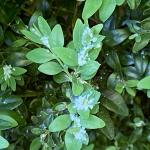 Viburnum leaf beetles are enlarging and causing serious damage on susceptible viburnum varieties. Boxwood psyllid (Psylla buxi) was observed on some boxwoods. Boxwood psyllid feeding injury produces cupping and curling of the leaves, enclosing several nymphs in the leaf pockets. The nymphs also produce white, fluffy secretions. Prune out and dispose of infested branch tips. Boxwood psyllid nymphs can be controlled with horticultural oil or insecticidal soap. Weeds observed in flower include: dandelion (Taraxacum officinale), ground ivy (Glechoma hederacea), garlic mustard (Alliaria petiolata), deadnettle (Lamium purpureum), common chickweed (Stellaria media), and common groundsel (Senecio vulgaris). Mosquitoes and ticks are very active. Protect yourself with a repellent when working outdoors.
Viburnum leaf beetles are enlarging and causing serious damage on susceptible viburnum varieties. Boxwood psyllid (Psylla buxi) was observed on some boxwoods. Boxwood psyllid feeding injury produces cupping and curling of the leaves, enclosing several nymphs in the leaf pockets. The nymphs also produce white, fluffy secretions. Prune out and dispose of infested branch tips. Boxwood psyllid nymphs can be controlled with horticultural oil or insecticidal soap. Weeds observed in flower include: dandelion (Taraxacum officinale), ground ivy (Glechoma hederacea), garlic mustard (Alliaria petiolata), deadnettle (Lamium purpureum), common chickweed (Stellaria media), and common groundsel (Senecio vulgaris). Mosquitoes and ticks are very active. Protect yourself with a repellent when working outdoors.
East (Boston)
General Conditions:
Over the past week, daytime temperatures have averaged 73° F with a high of 86° F on the 28th. Overnight temperatures averaged 46° F. We received an insignificant 0.10 inch of precipitation on May 24th. Plants in bloom include: Baptisia spp. (false indigo), Chionanthus virginicus (white fringetree), Cornus alternifolia (pagoda dogwood), Kalmia latifolia (mountain laurel), Linnaea amabilis - formerly Kolkwitzia amabilis (beauty bush), Lupinus perennis (wild lupine), Nepeta spp. (catmint), Physocarpus opulifolius (common ninebark), Sambucus canadensis (common elderberry) and Wisteria frutescens ‘Amethyst Falls’.
Pests/Problems:
Conditions have been consistently warm and dry. We received precipitation on only nine of 31 days in May, totaling 2.37 inches. Soils are dry; recent transplants require supplemental irrigation. Yellow nutsedge (Cyperus esculentus) continues to emerge in mulched beds. Multiflora rose (Rosa multiflora) is flowering in disturbed woodland edges. Viburnum leaf beetle (Pyrrhalta viburni) larvae are actively feeding on the foliage of susceptible viburnums.
Metro West (Acton)
General Conditions:
Moderate temperatures, mild winds, and dry weather conditions prevailed this reporting period, especially over the Memorial Day holiday weekend, with temperatures in the 70s and 80s. A high temperature of 88° F was recorded on the 28th and a low of 39° F was recorded on the 26th. The average monthly rainfall for May is 3.37” and 2.66” was recorded for this area. There is not any rain in the forecast for the last day of the month so it is unlikely that there will be any gain in precipitation. For the month of June, the average monthly rainfall is 3.93”.
Pests/Problems:
Upon further observation, the damage from the heavy frost experienced during the previous reporting period on May 18th is more extensive than previously reported. In several low-lying areas, there is complete frost damage to the foliage of Celastrus orbiculatus (Oriental bittersweet) and scattered on Quercus (oak) tender new foliage. In this area, skies were hazy on the 30th, most likely due to the smoke from the wildfires in Canada, potentially those in Nova Scotia.
Central Region (Boylston)
General Conditions:
Temperatures were average for the time of year during this reporting period, with high temperatures peaking at 86° F and low temperatures staying above 40° F all week. No significant precipitation, leaving us with under three inches of rain for the month of May. Given the cooler evening temperatures, soils are remaining relatively moist, but frequent irrigation is necessary on all new plantings. Many plants are in bloom across the landscape, including two native orchids: pink lady’s slipper (Cypripedium acaule) and large whorled pogonia (Isotria verticillata).
Pests/Problems:
Dry weather has led to a low incidence of foliar disease to this point in the season; however, powdery mildew caused by Podosphaera physocarpi was observed on common ninebark (Physocarpus opulifolius). Powdery mildew can lead to nearly total defoliation on susceptible cultivars and significantly impact the ornamental value of this popular native shrub, which is beginning to flower.
Pioneer Valley (Amherst)
General Conditions:
Near perfect conditions closed out the month of May, with cloudless skies and mild temperatures in the 70s and 80s. Nighttime temperatures have still been cool, with lows dropping into the 40s. The lack of precipitation this month is now a significant concern. The soaking rainfall we experienced on 5/20 replenished soils but the endless sun and low humidity has once again dried the upper soil horizon. Landscapes in full sun with well-drained soils are really getting dry. As of 5/30, there are no water use restrictions across the tri-counties. Avoid daily watering of trees and shrubs as this amount of water is unnecessary and possibly harmful. Instead, provide a deep watering of the tree’s root system on an interval of five to seven days to promote a vigorous root system. Short duration irrigation can promote an abundance of fine roots near the soil surface, which can actually make plants more susceptible to drought stress later in the summer. Dry periods like the one we are experiencing helps to suppress certain foliar and stem cankering pathogens. However, this benefit is negated by overhead watering, especially on plants like boxwood and Japanese maple. Provide irrigation directly to the soil and avoid excessive wetting of the canopy. There’s a good chance of scattered showers in the long-term forecast but summer precipitation is often very spotty in occurrence and accumulation. The landscape continues to look lush with a variety of plants in bloom, including fringetree (Chionanthus), yellowwood (Cladrastis), various Rhododendrons, mountain laurel and kousa dogwood. Crickets, tree frogs, toads and bullfrogs continue to be heard at various times of the day. Pollen levels have dropped a bit recently but with eastern white pines up next, this potent pollen season will likely resume. Cottonwoods and other Populus species are dispersing seed and the floating white masses are always a site to behold in the valley. The floodplain forests along the Connecticut River and its tributaries support some truly massive eastern cottonwoods.
Pests/Problems:
Mosquitoes and black flies are out in full force despite the lack of regular rainfall. Thankfully the latter will wane in a few weeks. Apple scab is abundant right now on crabapples and some early season leaf shedding has been observed. The late April rain set off the season’s infections and despite the dry May, it appears the predictions of a big year for this disease will hold true. We continue to experience the fallout from the 5/18 frost in the valley. Numerous woody and non-woody plants experienced some form of damage. Symptoms of injury range from blighted shoot tips, brown and blackened foliage, and deformed/distorted shoots and foliage. Japanese knotweed was badly injured from the cold temperatures that morning but plants were not killed outright. Despite the dead tops, this nefarious invasive will resume growth. According to the UMass Cold Spring Orchard, apples in some locations throughout the region were badly injured from the frost/freeze. It’s believed that harvests will be lower this year for certain varieties. Continue to very carefully scout trees and shrubs for any evidence of insect feeding or disease so that early intervention can take place. Maple anthracnose appears to be abundant this year on a variety of forest and landscape maples. Sycamore anthracnose is also keeping many sycamores nearly devoid of foliage but it’s still too early to determine if this is a particularly bad year. Many trees may be able to mostly or fully leaf out during June.
Berkshire Region (West Stockbridge)
General Conditions:
With the exception of a spotty bit of very brief high wind and rain on May 24, it was a dry week. Rainfall amounts from that very brief storm were 0.13 inches in Pittsfield and 0.06 inches in North Adams and Richmond. No rain has occurred here in West Stockbridge since May 20th. Currently, soils are dry to a depth of about 1-2 inches and barely moist below that depth. Still, with the exception of newly planted materials, few plants are showing any effects from this dry spell. It is expected that some rainfall will occur by the end of this week. According to data from Pittsfield, normal rainfall from May 1 to May 30 is 3.65 inches but this year the month to date rainfall amount has been 2.18 inches. Several areas of the county experienced some frost, albeit a light one, on May 26th. Both North Adams and Richmond recorded a temperature of 32° F on that date. Of course, low spots could have had temperatures a bit lower than that but none were as damaging as the hard freeze of May 18. The high temperatures for the week all occurred on May 28 with 83° F at both North Adams and Richmond and 82° F in Pittsfield. The impact of the hard freeze of May 18 is still quite visible with many of the affected plants still showing wilted and dead foliage. Yet many of these plants are showing signs of new growth emerging from latent buds. However, there are some plants, mostly trees, that remain sparsely foliated or have been very slow to develop new growth.
Pests/Problems:
Scouting found a few more problems than in previous weeks. Damage from spongy moth caterpillars is currently limited to holes in leaves of a wide variety of trees and shrubs, yet there is no total defoliation yet observed. The caterpillars are, for the most part, still quite small. The numbers also seem somewhat fewer than last year. The impact remains to be seen. Eastern tent caterpillars are still active but their numbers also appear fewer than in past years. Other pests observed include: red aphids on asters and other herbaceous plants, leaf tier caterpillars, lily leaf beetle adults, elongate hemlock scale on hemlocks and firs, woolly beech aphid, pear blister mite, spruce spider mite, leaf spot midge on red maple, and rose slugs. Few diseases were observed. The most prominent were apple scab and cedar apple rust on crabapples. Leaf spots were also found on maples. Turf grass showed some browning, particularly where lawns were mowed very low.
Regional Scouting Credits
- CAPE COD REGION - Russell Norton, Horticulture and Agriculture Educator with Cape Cod Cooperative Extension, reporting from Barnstable.
- SOUTHEAST REGION - Brian McMahon, Arborist, reporting from the Dighton area.
- NORTH SHORE REGION - Geoffrey Njue, Green Industry Specialist, UMass Extension, reporting from the Long Hill Reservation, Beverly.
- EAST REGION - Kit Ganshaw & Sue Pfeiffer, Horticulturists reporting from the Boston area.
- METRO WEST REGION – Julie Coop, Forester, Massachusetts Department of Conservation & Recreation, reporting from Acton.
- CENTRAL REGION - Mark Richardson, Director of Horticulture reporting from New England Botanic Garden at Tower Hill, Boylston.
- PIONEER VALLEY REGION - Nick Brazee, Plant Pathologist, UMass Extension Plant Diagnostic Lab, reporting from Amherst.
- BERKSHIRE REGION - Ron Kujawski, Horticultural Consultant, reporting from Great Barrington.
Woody Ornamentals
Diseases
Recent pests, pathogens, or problems of interest seen in the UMass Extension Plant Diagnostic Lab, a select few:
Beech leaf disease, caused by the foliar nematode Litylenchus crenatae ssp. mccanii, on a European beech (Fagus sylvatica). Very large and old landscape tree that did not show major symptoms last year. It resides in a full sun setting with good drainage and has appeared otherwise healthy in previous years. Currently, the canopy appears thin with many buds that did not flush this season. Interveinal banding and convex cupping was present on symptomatic foliage. There have been several reports of rapidly intensifying BLD symptoms on infested beech in eastern Massachusetts. Trees that had minor to moderate symptoms last season appear badly diseased this year and may not survive the season. It’s unclear why BLD is advancing so rapidly in this region, after initial reports from the Midwest suggested a slower progression of disease development on mature trees. It’s possible that drought stress and winter injury may also be playing a role in decline, given the extreme heat and lack of precipitation during the summer of 2022, followed by an abnormal winter with a damaging arctic cold snap in early February of 2023.
Shoot tip blight on Korean fir (Abies koreana) due to the 5/18 frost event. Four trees, representing dwarf cultivars, that are less than 10-years-old and were planted last year. The trees reside in amended soils with full sun, drip irrigation and regular scouting. Shoot tips and tender foliage were frozen during the early morning hours of 5/18 and soon became brown and wilted. Some scattered shoots escaped injury and the trees have continued to flush new growth. Given that true firs (Abies) hold their needles for many years, these trees should be able to withstand the loss of the current season’s growth and resume healthy growth next spring.
Armillaria root rot of a mature northern red oak (Quercus rubra). The tree was approximately 35″ in diameter and at least 75-years-old. It recently uprooted and landed on a nearby three-story building at a small liberal arts college. The canopy was mostly full but did appear thin and there was obvious fine twig dieback. The base of the tree was surrounded by a small wood frame and mulched with wood chips. However, most of the root zone was occupied by compacted turfgrass. The main lateral roots exposed after uprooting were clearly decayed. The submitted root sections had rhizomorphs attached and wood that was bleached and stringy when pulled apart, which is typical after infection by a white rot pathogen like Armillaria. When the outer root bark was shaved, white mycelial fans were present. Oaks are capable of harboring significant decay without showing major symptoms, as was the case here.
Winter injury on Japanese holly (Ilex crenata) and cherry laurel (Prunus laurocerasus) caused by the arctic freeze in early February. Three plants at two sites, all in full sun with drip irrigation. Submitted branch segments had pale green to brown leaves that were dry and brittle. The stems were dead but there was no evidence of any stem cankering activity (e.g. discolored vascular tissue). Various Ilex species suffered serious injury from this event along with other semi-hardy plants in the region, such as cherry laurel. While the latter often does well in coastal areas of southern New England, according to Dirr it’s only hardy to zone 6.
Report by Nick Brazee, Plant Pathologist, UMass Extension Plant Diagnostic Lab, UMass Amherst.
Interesting Insects Reported or Seen Recently
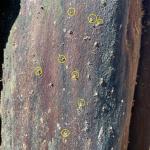
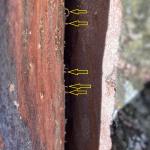 Ambrosia Beetles on Kwanzan Cherry (Prunus ‘Kwanzan’): Evidence of ambrosia beetle attack was recently reported from Kwanzan cherry. Signs include tiny, round entrance holes in the bark of the host plant which mark the start of a gallery entrance. Sometimes protruding out of these tiny holes are toothpick-like chewed wood material that may be up to 1.2-1.6 inches long. These toothpick-like projections are not always visible – for example, they can be weathered away by wind or rain. Because the adult ambrosia beetles are not feeding on the wood, these “toothpicks” are not frass (excrement) but rather excavated wood from the creation of the tunnels (galleries) beneath the bark. Sap stains on the bark where entrance holes exist may be common in the spring or late summer/early fall. Attacked trees may exhibit wilting foliage, branch dieback, or symptoms similar to certain abiotic stressors. Photos of the toothpick-like excavated wood and the tiny, round entrance holes above (observed on Kwanzan cherry on 5/26/2023 and photographed by Matt McCoy).
Ambrosia Beetles on Kwanzan Cherry (Prunus ‘Kwanzan’): Evidence of ambrosia beetle attack was recently reported from Kwanzan cherry. Signs include tiny, round entrance holes in the bark of the host plant which mark the start of a gallery entrance. Sometimes protruding out of these tiny holes are toothpick-like chewed wood material that may be up to 1.2-1.6 inches long. These toothpick-like projections are not always visible – for example, they can be weathered away by wind or rain. Because the adult ambrosia beetles are not feeding on the wood, these “toothpicks” are not frass (excrement) but rather excavated wood from the creation of the tunnels (galleries) beneath the bark. Sap stains on the bark where entrance holes exist may be common in the spring or late summer/early fall. Attacked trees may exhibit wilting foliage, branch dieback, or symptoms similar to certain abiotic stressors. Photos of the toothpick-like excavated wood and the tiny, round entrance holes above (observed on Kwanzan cherry on 5/26/2023 and photographed by Matt McCoy).
It is possible that the ambrosia beetle species responsible for the damage observed here belong to the genus Xylosandrus. In particular, two non-native species are known to occur in North America that have the potential to be significant pests of ornamental plants in landscapes and nurseries. X. crassiusculus (the granulate ambrosia beetle) and X. germanus (the black stem borer) have both been previously detected in parts of Massachusetts, either through samples received by the UMass Plant Diagnostic Laboratory or detected in Early Detection Rapid Response (EDRR) traps hung by state and federal agencies who monitor for bark and ambrosia beetles. X. crassiusculus has been trapped in Bristol County, MA previously in 2010; X. germanus has also been previously reported in MA and detected in samples from landscape specimen trees and shrubs.
Over 200 species of host plant have been recorded for X. germanus and over 120 species for X. crassiusculus. These include deciduous and coniferous hosts, mainly thin-barked species from ornamental nurseries or tree fruit orchards. In ornamental nurseries, dogwood, honeylocust, Japanese snowbell, magnolia, maple, oak, and redbud may be favored. Kwanzan cherry has also been reported as a suitable host. Stems and trunks of the host plant are preferred for attack over the branches by these beetles. Plants of varying sizes or species may be utilized (Ranger et al., 2016).
In both species, adults overwinter in galleries within infested host plants as mated females. When spring temperatures warm enough, they disperse and look for new host plants (in particular, those suffering from other stressors; however, they may attack otherwise apparently healthy hosts as well). Some authors argue that they only prefer stressed host plants, and that symptoms of the other stressors involved may not always be readily identified by the observer. A brood chamber is constructed and eggs are laid within. X. germanus (black stem borer) may lay up to 18 eggs per female. X. crassiusculus (granulate ambrosia beetle) can lay 1-6 eggs per day over a long period of time. Egg laying only begins after the female has successfully inoculated the brood chamber with symbiotic fungi (Ambrosiella grosmanniae is symbiotic with X. germanus and A. roeperi is symbiotic with X. crassiusculus in the US). The majority of the fungus is found in the xylem. Eggs hatch in approximately 2-6 days and the larvae begin to feed on the ambrosia fungi within their brood chambers and galleries.
The length of time it takes the black stem borer to develop from egg to adult (and move through the larval and pupal stages) has been reported in the literature as anywhere between 15-25 days. The length of time for the granulate ambrosia beetle to develop has not been reported. One or two generations per year have been reported for X. germanus, depending on the location. X. crassiusculus may have up to four generations per year in the warmest parts of its native or invaded range. One or two days of at least 68o F temperatures are required before overwintering adults fly and disperse to new hosts (Reding et al., 2013a). Depending upon location, flights may start Feb/March or March/April and last until September/October. Peak daily flight activity has been observed from the late afternoon into the night, with most flights occurring low to the ground. For example, in both species, traps placed at approximately 3 ft. high seem to catch more beetles (Ranger et al., 2016).
Cultural management options are the most important when it comes to preventing (and thus halting) ambrosia beetle attack. Unfortunately, no reliable rescue treatments (chemical management options) for ambrosia beetles currently exist. Therefore, prevention of attack is essential in managing these insects. Strategies include planting the right plant on the right site, proper planting, reducing plant stress, increasing plant vigor, and preventing flooding or drought stress in particular. Such factors as poor drainage, plant unsuitability for the growing site, and predisposition to frost injury or low temperature stress, are all important factors that predispose host plants to attack by these beetles. Trap trees can be used to attract dispersing adults to them, but they should be removed and chipped before new adults emerge. Dying plants or brush piles in ornamental nurseries should be burned or chipped annually to prevent beetle dispersal from infested materials.
Some natural enemies of these ambrosia beetles exist. No parasitoids have been found associated with X. germanus. Predatory clerid beetles are known to feed on ambrosia beetles in the literature, however no specific species have been identified for either the black stem borer and granulate ambrosia beetles. Certain strains of Beauveria bassiana and Metarhizium anisopliae have been associated with high mortality of adult female black stem borers. Infection with these insect killing fungi also caused the number of females forming galleries and laying eggs to decrease and in some cases 100% of progeny became infected. Efficacy of insecticide sprays (coating the trunk and stems of susceptible hosts) has been variable according to a few research studies. Cypermethrin and bifenthrin were reported to be effective against X. crassiusculus, while permethrin, chlorpyrifos, and esfenvalerate were less effective (Mizell and Riddle, 2004). Frank and Bambara (2009) found acephate, cyfluthrin, fenpropathrin, imidacloprid, and thiamethoxam to be ineffective as contact sprays. Permethrin has shown variable effectiveness in a few studies, but it is suggested that repeated applications may be necessary to prevent colonization of the plant by these ambrosia beetles. Thorough coverage of the main trunk is necessary if using chemical management options, as the majority of attacks by both species of ambrosia beetle occur in this area (Ranger et al., 2016).
Insects and Other Arthropods
- Deer Tick/Blacklegged Tick: Ixodes scapularis adults are active all winter and spring, as they typically are from October through May, and “quest” or search for hosts at any point when daytime temperatures are above freezing. Engorged females survive the winter and will lay 1,500+ eggs in the forest leaf litter beginning around Memorial Day (late May). For images of all deer tick life stages, along with an outline of the diseases they carry, visit:
https://www.capecod.gov/departments/cooperative-extension/programs/ticks-bugs/ or https://web.uri.edu/tickencounter/species/blacklegged-tick/.
Anyone working in the yard and garden should be aware that there is the potential to encounter deer ticks. The deer tick or blacklegged tick can transmit Lyme disease, human babesiosis, human anaplasmosis, and other diseases. Preventative activities, such as daily tick checks, wearing appropriate clothing, and permethrin treatments for clothing (according to label instructions) can aid in reducing the risk that a tick will become attached to your body. If a tick cannot attach and feed, it will not transmit disease. For more information about personal protective measures, visit:
https://www.capecod.gov/departments/cooperative-extension/programs/ticks-bugs/
The UMass Center for Agriculture, Food, and the Environment provides a list of potential tick identification and testing resources.
In the news: UMass Amherst has now been designated as the location for the New England Center of Excellence in Vector-Borne Diseases (NEWVEC). This CDC (Centers for Disease Control and Prevention) funded center will work to reduce the risk of vector-borne diseases spread by ticks, mosquitoes, and other blood-sucking insects or insect relatives in New England: https://www.umass.edu/news/article/cdc-designates-new-england-center-excellence-vector-borne-diseases-umass-amherst. For more information, see NEWVEC and their Spring 2023 Project ITCH (“Is Tick Control Helping”).
Note: Dog ticks (Dermacentor variabilis) continue to be noticeably active in parts of Berkshire and Hampshire County in 2023. They are present in large numbers this year even in environments where tick activity is typically low, such as in mowed lawns.
- Mosquitoes: According to the Massachusetts Bureau of Infectious Disease and Laboratory Science and the Department of Public Health, there are at least 51 different species of mosquito found in Massachusetts. Mosquitoes belong to the Order Diptera (true flies) and the Family Culicidae (mosquitoes). As such, they undergo complete metamorphosis and possess four major life stages: egg, larva, pupa, and adult. Adult mosquitoes are the only stage that flies and many female mosquitoes only live for 2 weeks (although the life cycle and timing will depend upon the species). Only female mosquitoes bite to take a blood meal and this is so they can make eggs. Mosquitoes need water to lay their eggs in, so they are often found in wet or damp locations and around plants. Different species prefer different habitats. It is possible to be bitten by a mosquito at any time of the day and, again, timing depends upon the species. Many are particularly active from just before dusk, through the night, and until dawn. Mosquito bites are not only itchy and annoying, but they can be associated with greater health risks. Certain mosquitoes vector pathogens that cause diseases such as West Nile virus (WNV) and eastern equine encephalitis (EEE). More information about mosquitoes in Massachusetts. There are ways to protect yourself against mosquitoes, including wearing long-sleeved shirts and long pants, keeping mosquitoes outside by using tight-fitting window and door screens, and using insect repellents as directed. Products containing the active ingredients DEET, permethrin, IR3535, picaridin, and oil of lemon eucalyptus provide protection against mosquitoes. Be aware that not all of these can be safely used on young children. Read and follow all label instructions for safety and proper use. For more information about mosquito repellents, visit: https://www.mass.gov/service-details/mosquito-repellents and https://www.cdc.gov/mosquitoes/mosquito-bites/prevent-mosquito-bites.html
- Wasps/Hornets: Many wasps are predators of other arthropods, including pest insects such as certain caterpillars that feed on trees and shrubs. Adult wasps hunt prey and bring it back to their nest where young are being reared as food for the immature wasps. A common such example are the paper wasps (Polistes spp.) who rear their young on chewed up insects. They may be seen searching plants for caterpillars and other soft-bodied larvae to feed their young. Paper wasps can sting and will defend their nests, which are open-celled paper nests that are not covered with a papery “envelope”. These open-celled nests may be seen hanging from eaves or other outdoor building structures. Aerial yellow jackets and hornets create large aerial nests that are covered with a papery shell or “envelope”. Common yellow jacket species include those in the genus Vespula. Dolichovespula maculata is commonly known as the baldfaced hornet, although it is not a true hornet. The European hornet (Vespa crabro) is three times the size of a yellow jacket and may be confused for the northern giant hornet (Vespa mandarinia). The European hornet is known to Massachusetts, but the northern giant hornet is not. If you are concerned that you have found or photographed a northern giant hornet, please report it. Paper wasps and aerial yellowjackets overwinter as fertilized females (queens) and a single female produces a new nest annually in the late spring. Queens start new nests, lay eggs, and rear new wasps to assist in colony/nest development. Nests are abandoned at the end of the season. Some people are allergic to stinging insects, so care should be taken around wasp/hornet nests. Unlike the European honeybee (Apis mellifera), wasps and hornets do not have barbed stingers and therefore can sting repeatedly when defending their nests. It is best to avoid them, and, if that cannot be done and assistance is needed to remove them, consult a professional.
Highlighted Invasive Insects & Other Organisms Update:
-
Spongy Moth: Lymantria dispar egg hatch was reported on April 18, 2023, in Great Barrington, MA (Berkshire County) and on 5/2/2023 in Erving and Millers Falls, MA (Franklin County). Since then, we’ve had a confusing period of rain events and saturation alternating with dry soils and cool weather (including in some spots frosts and snow flurries, depending upon location) alternating with unseasonably warm spells. As warmer temperatures again return, and as discussed in the previous Landscape Message, individuals living and working in parts of Berkshire and Franklin Counties may wonder what to expect from spongy moth this year. While it is difficult to predict, scouts and professionals from Berkshire County report seeing spongy moth caterpillars feeding on susceptible host plant foliage recently. Reports from scouts on Cape Cod also indicate some spongy moth presence in eastern MA (see previous Landscape Message). The expectation is that parts of western MA may experience noticeable defoliation by this insect again in 2023. By the end of June and the beginning of July, most of this feeding will have occurred and we will be able to tell whether or not defoliation has again been significant. Additionally, by that time, whether or not the population is hit by an epizootic of the spongy moth caterpillar killing fungus Entomophaga maimaiga will be noticeably detectable as well.
For more information about spongy moth, view the first episode of InsectXaminer.
Why did the common name for Lymantria dispar change recently? 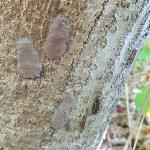 Spotted Lanternfly: (Lycorma delicatula, SLF) is a non-native, invasive insect that feeds on over 103 species of plants, including many trees and shrubs that are important in our landscapes. It overwinters as an egg mass (see pictures), which the adult female insect lays on just about any flat surface. Spotted lanternfly egg masses have begun hatching as of the week of May 26, 2023, in Springfield, MA! The MA Department of Agricultural Resources (MDAR) reports seeing spotted lanternfly nymphs hatching from and resting on their egg masses in areas of Springfield where a breeding population of this insect has become established. Some nymphs had already begun to migrate away from the locations where their egg masses are located. UMass Extension thanks MDAR for sharing these reports! Updates about spotted lanternfly egg hatch in Massachusetts may soon be posted by MDAR.
Spotted Lanternfly: (Lycorma delicatula, SLF) is a non-native, invasive insect that feeds on over 103 species of plants, including many trees and shrubs that are important in our landscapes. It overwinters as an egg mass (see pictures), which the adult female insect lays on just about any flat surface. Spotted lanternfly egg masses have begun hatching as of the week of May 26, 2023, in Springfield, MA! The MA Department of Agricultural Resources (MDAR) reports seeing spotted lanternfly nymphs hatching from and resting on their egg masses in areas of Springfield where a breeding population of this insect has become established. Some nymphs had already begun to migrate away from the locations where their egg masses are located. UMass Extension thanks MDAR for sharing these reports! Updates about spotted lanternfly egg hatch in Massachusetts may soon be posted by MDAR.
Currently, the only established populations of spotted lanternfly in Massachusetts are in Fitchburg, Shrewsbury, Worcester, and Springfield MA. Therefore, there is no reason to be preemptively treating for this insect in other areas of Massachusetts. If you suspect you have found spotted lanternfly in additional locations, please report it immediately to MDAR. If you are living and working in the Fitchburg, Shrewsbury, Worcester, and Springfield, MA areas, please be vigilant and continue to report anything suspicious.
For More Information:
From UMass Extension:
*New*: Spotted Lanternfly Management Guide for Professionals - *Note that management may only be necessary in areas where this insect has become established in Massachusetts and if high value host plants are at risk. Preemptive management of the spotted lanternfly is not recommended.
InsectXaminer episode about spotted lanternfly adults and egg masses!
From the MA Department of Agricultural Resources (MDAR):
Fact Sheet and Map of Locations in MA
Spotted Lanternfly Management Guide for Homeowners in Infested Areas
*New*: Spotted Lanternfly Look-alikes in MA
*New*: Spotted Lanternfly Egg Mass Look-alikes
- Asian Longhorned Beetle: (Anoplophora glabripennis, ALB) Look for signs of an ALB infestation which include perfectly round exit holes (about the size of a dime), shallow oval or round scars in the bark where a female has chewed an egg site, or sawdust-like frass (excrement) on the ground nearby host trees or caught in between branches. Be advised that other, native insects may create perfectly round exit holes or sawdust-like frass, which can be confused with signs of ALB activity.
The regulated area for Asian longhorned beetle is 110 square miles encompassing Worcester, Shrewsbury, Boylston, West Boylston, and parts of Holden and Auburn. If you believe you have seen damage caused by this insect, such as exit holes or egg sites, on susceptible host trees like maple, please call the Asian Longhorned Beetle Eradication Program office in Worcester, MA at 508-852-8090 or toll free at 1-866-702-9938.
To report an Asian longhorned beetle find online or compare it to common insect look-alikes, visit: http://massnrc.org/pests/albreport.aspx or https://www.aphis.usda.gov/pests-diseases/alb/report.
- White Spotted Pine Sawyer (WSPS): Monochamus scutellatus adults can emerge in late May throughout July, depending on local temperatures. White spotted pine sawyers have been seen in Western Massachusetts in recent weeks, arriving right on time in the last two weeks of May. This is a native insect in Massachusetts and is usually not a pest. Larvae develop in weakened or recently dead conifers, particularly eastern white pine (Pinus strobus). However, the white spotted pine sawyer looks very similar to the invasive Asian Longhorned Beetle (ALB), Anoplophora glabripennis. ALB adults do not emerge in Massachusetts until July and August. Beginning in July, look for the key difference between WSPS and ALB adults, which is a white spot in the top center of the wing covers (the scutellum) on the back of the beetle. White spotted pine sawyer will have this white spot, whereas Asian longhorned beetle will not. Both insects can have other white spots on the rest of their wing covers; however, the difference in the color of the scutellum is a key characteristic. See the Asian longhorned beetle entry above for more information about that non-native insect.
 Emerald Ash Borer: (Agrilus planipennis, EAB) has been detected in at least 11 out of the 14 counties in Massachusetts (map of these locations in MA). Additional information about this insect is provided by the MA Department of Conservation and Recreation at https://storymaps.arcgis.com/stories/b60f63199fa14805a8b9f7c82447a25b.
Emerald Ash Borer: (Agrilus planipennis, EAB) has been detected in at least 11 out of the 14 counties in Massachusetts (map of these locations in MA). Additional information about this insect is provided by the MA Department of Conservation and Recreation at https://storymaps.arcgis.com/stories/b60f63199fa14805a8b9f7c82447a25b.
This wood-boring beetle readily attacks ash (Fraxinus spp.) including white, green, and black ash and has also been found developing in white fringe tree (Chionanthus virginicus) and has been reported in cultivated olive (Olea europaea). Signs of an EAB infested tree may include D-shaped exit holes in the bark (from adult emergence), “blonding” or lighter coloration of the ash bark from woodpecker feeding (chipping away of the bark as they search for larvae beneath), and serpentine galleries visible through splits in the bark from larval feeding beneath. It is interesting to note that woodpeckers are capable of eating 30-95% of the emerald ash borer larvae found in a single tree (Murphy et al. 2018). Unfortunately, despite high predation rates, EAB populations continue to grow. However, there is hope that biological control efforts will eventually catch up with the emerald ash borer population and preserve some of our native ash tree species for the future.
-
Jumping Worms: Amynthas spp. earthworms, collectively referred to as “jumping or crazy or snake” worms, overwinter as eggs in tiny, mustard-seed sized cocoons found in the soil or other substrate (ex. compost). Immature jumping worms hatch from their eggs by approximately mid-to-late May. It may be impossible to see them at first, and it may be more likely that jumping worms are noticed when the first adults begin to appear at the end of May and in June. It is easy to misidentify jumping worms (ex. mistake European earthworms for jumping worms) if only juveniles are found. In August and September, most jumping worms have matured into the adult life stage and identification of infestations is more likely to occur at that time of year.
For More Information:
UMass Extension Fact Sheets:
- Earthworms in Massachusetts – History, Concerns, and Benefits
- Jumping/Crazy/Snake Worms – Amynthas spp.
- A Summary of the Information Shared at UMass Extension’s Jumping Worm Conference in January 2022
- Invasive Jumping Worm Frequently Asked Questions (Over 70 Questions and their Answers)
Tree & Shrub Insect Pests(Native and Invasive):
- Andromeda Lace Bug: Stephanitis takeyai is most commonly encountered on Japanese andromeda. Eggs are tiny and inserted into the midveins on the lower surface of the leaf and covered with a coating that hardens into a protective covering. Five nymphal stages are reported. Nymphs are different in appearance from the adults, often covered with spiky protrusions. 3-4 generations per year have been observed in New England, with most activity seen between late-May into September (starting at approximately 120 GDD’s, base 50°F). Both nymphs and adults can be seen feeding on leaf undersides. Adults have delicate, lace-like wings and what appears to be an "inflated hood" that covers their head. Adults are approximately 1/8 inch long. Arrived in the US in Connecticut in 1945 from Japan (Johnson and Lyon, 1991).
Can cause severe injury to Japanese andromeda, especially those in full sun. Mountain andromeda (Pieris floribunda) is highly resistant to this pest. Like other lace bugs, this insect uses piercing-sucking mouthparts to drain plant fluids from the undersides of the leaves. Damage may be first noticed on the upper leaf surface, causing stippling and chlorosis (yellow or off-white coloration). Lace bug damage is distinguished from that of other insects upon inspecting the lower leaf surface for black shiny spots, "shed" skins from the insects, and adult and nymphal lace bugs themselves.
A first sign of potential lace bug infestation is stippling or yellow/white colored spots or chlorosis on host plant leaf surfaces. Lace bugs excrete a shiny, black, tar-like excrement that can often be found on the undersides of infested host plant leaves. Flip leaves over to inspect for this when lace bug damage is suspected.
Mountain andromeda (Pieris floribunda) is considered to be highly resistant to this insect and can be used as an alternative for such plantings along with other lace bug-resistant cultivars. Consider replacing Japanese andromeda with mountain andromeda as a way to manage for this pest. Natural enemies are usually predators and sometimes are not present in large enough numbers in landscapes to reduce lace bug populations. Structurally and (plant) species complex landscapes have been shown to reduce azalea lace bug populations through the increase of natural enemies.
- Arborvitae Leafminer: In New England and eastern Canada, four species of leafminers are known to infest arborvitae. These include Argyresthia thuiella, A. freyella, A. aureoargentella, and Coleotechnites thujaella. The arborvitae leafminer, A. thuiella, is the most abundant of these and has the greatest known range when compared to the others (it is also found in the Mid-Atlantic States and as far west as Missouri). Moths of this species appear from mid-June to mid-July and lay their eggs. The damage caused by all of these species is nearly identical. Trees, however, have been reported to lose up to 80% of their foliage due to arborvitae leafminer and still survive. At least 27 species of parasites have been reported as natural enemies of arborvitae leafminers, the most significant of which may be a parasitic wasp (Pentacnemus bucculatricis). Arborvitae leafminer damage causes the tips of shoots and foliage to turn yellow and brown. If infestations are light, prune out infested tips.
- Azalea Lace Bug: Stephanitis pyrioides is native to Japan. The azalea lace bug deposits tiny eggs on the midveins on leaf undersides. They then cover the area where the egg was inserted with a brownish material that hardens into a protective covering. Each female may lay up to 300 eggs (University of Florida). Nymphs hatch from the eggs and pass through 5 instars. The length of time this takes depends on temperature. Between 2 and 4 generations may be completed in a single year. In Maryland, there are four generations per year. Adults are approximately 1/10 inch long with lacy, cream colored, transparent wings held flat against the back of the insect. Wings also have black/brown patches. Adults of this species also possess a "hood" over their head. Nymphs are colorless upon hatching, but develop a black color as they mature and are covered in spiny protrusions.
Immatures and adults use piercing-sucking mouthparts to remove plant fluids from leaf tissues. This feeding leaves behind white-yellow stippling on the upper surface of host plant leaves, even though the insects themselves feed on the underside of the leaf. Plants in full sun are often particularly damaged by these insects. In heavy infestations, plants in full sun may be killed by the feeding of the azalea lace bug.
Begin scouting for azalea lace bugs when 120 GDD’s (base 50°F) are reached. This species is active throughout the summer. Look for dark, black, tar-like spots of excrement deposited by immature and adult lace bugs on the underside of susceptible host plant leaves, especially on leaves with white-yellow stippling visible on the upper surface. If lace bugs are not already known to the location, check susceptible hosts located in full sun first. Monitor plants for lace bug feeding from late April through the summer.
Plant azaleas in partial shade. Resistance has been reported in Rhododendron atlanticum, R. arborescens, R. canescens, R. periclymenoides, and R. prunifolium.
Many of the natural enemies reported for this insect are predators. They are rarely abundant enough to reduce damaging populations of lace bugs, especially on plants in sunny locations. Structurally and (plant) species complex landscapes have been shown to reduce azalea lace bug populations through the increase of natural enemies.
- Azalea Sawflies: There are a few species of sawflies that impact azaleas. Johnson and Lyon's Insects that Feed on Trees and Shrubs mentions three of them. Amauronematus azaleae was first reported in New Hampshire in 1895 and is likely found in most of New England. Adults of this species are black with some white markings and wasp-like. Generally, green larvae feed mostly on mollis hybrid azaleas. Remember, sawfly caterpillars have at least enough abdominal prolegs to spell “sawfly” (so 6 or more prolegs). Adults are present in May and females lay their eggs; larvae then hatch and feed through the end of June. There is one generation per year. Nematus lipovskyi has been reared from swamp azalea (Rhododendron viscosum). Adults of that species have been collected in April (in states to the south) and May (in New England) and larval feeding is predominantly in late April and May in Virginia and June in New England. One generation of this species occurs per year, and most mollis hybrid azaleas can be impacted. A third species, Arge clavicornis, is found as an adult in July and lays its eggs in leaf edges in rows. Larvae are present in August and September. Remember, Bacillus thuringiensis Kurstaki does not manage sawflies.
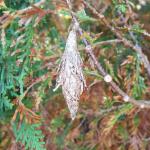 Bagworm:Thyridopteryx ephemeraeformis is a native species of moth whose larvae construct bag-like coverings over themselves with host plant leaves and twigs. This insect overwinters in the egg stage within the bags of deceased females from last season. Eggs may hatch and young larvae are observed feeding around mid-June, or roughly between 600-900 GDD’s. Egg hatch is coming soon! Now is the time to scout for and remove and destroy overwintered bags. In recent years, an increase in bagworm activity (particularly in urban forests) in Massachusetts has been noticed by professionals. Thus far in 2023, reports have been made from Plymouth County, MA.
Bagworm:Thyridopteryx ephemeraeformis is a native species of moth whose larvae construct bag-like coverings over themselves with host plant leaves and twigs. This insect overwinters in the egg stage within the bags of deceased females from last season. Eggs may hatch and young larvae are observed feeding around mid-June, or roughly between 600-900 GDD’s. Egg hatch is coming soon! Now is the time to scout for and remove and destroy overwintered bags. In recent years, an increase in bagworm activity (particularly in urban forests) in Massachusetts has been noticed by professionals. Thus far in 2023, reports have been made from Plymouth County, MA. - Boxwood Leafminer: Monarthropalpus flavus partly grown fly larvae overwinter in the leaves of susceptible boxwood. Yellowish mines may be noticeable on the undersides of leaves. This insect grows rapidly in the spring, transforming into an orange-colored pupa. After pupation, adults will emerge and white colored pupal cases may hang down from the underside of leaves where adults have emerged. Adults may be observed swarming hosts between 300-650 GDD’s, or roughly the end of May through June. Most cultivars of Buxus sempervirens and B. microphylla are thought to be susceptible. Resistant cultivars such as ‘Vardar Valley’ and ‘Handsworthiensis’ are good choices at sites where this insect has been a problem.
- Boxwood Mite: Eurytetranychus buxi overwinter as tiny eggs on boxwood leaves and hatch mid-spring. These mites are tiny (about the size of a period) and difficult to detect. Feeding may cause plants to appear off-color. If management is deemed necessary, the timing for treatment may be between 245-600 GDD’s.
- Boxwood Psyllid: Psylla buxi feeding can cause cupping of susceptible boxwood leaves. Leaf symptoms/damage may remain on plants for up to two years. English boxwood may be less severely impacted by this pest. Eggs overwinter, buried in budscales, and hatch around budbreak of boxwood. Eggs may hatch around 80 GDD’s. While foliar applications may be made between 290-440 GDD’s, the damage caused by this insect is mostly aesthetic. Therefore, typically, management is not necessary.
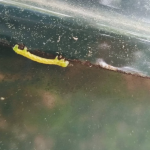 Cankerworms: Alsophila pometaria (fall cankerworm) and Paleacrita vernata (spring cankerworm) are often confused for winter moth (Operophtera brumata). Cankerworm populations in eastern MA, particularly on areas of Cape Cod, were confused for winter moth in 2019. Spring cankerworm adults are active in February and March, and fall cankerworm adults are active in late November into early December. During these times, both species lay eggs. These native insects most commonly utilize elm, apple, oak, linden, and beech. Eggs of both species hatch as soon as buds begin to open in the spring. Caterpillars occur in mixed populations and are often noticeable by mid-May in MA. Young larvae feed on buds and unfolding leaves. There are two color forms (light green and dark) for caterpillars of both species. Fall cankerworm was reported from Barnstable County on 5/24/2023. See photo above from Tamar Haspel who shares that the fall cankerworm caterpillars in the forest near them are so abundant that “if you put them together end to end you would get to the moon”. Like winter moth, they drop to the soil to pupate. This usually occurs in June. Fall cankerworm larvae have three pairs of prolegs (one of which is small so it is sometimes referred to as ½) and spring cankerworm have two pairs (winter moth caterpillars also have 2 pairs of prolegs). If populations are large and damage is noticeable on hosts, reduced risk insecticides such as Bacillus thuringiensis Kurstaki or spinosad may target larvae between approximately 148-290 GDD’s.
Cankerworms: Alsophila pometaria (fall cankerworm) and Paleacrita vernata (spring cankerworm) are often confused for winter moth (Operophtera brumata). Cankerworm populations in eastern MA, particularly on areas of Cape Cod, were confused for winter moth in 2019. Spring cankerworm adults are active in February and March, and fall cankerworm adults are active in late November into early December. During these times, both species lay eggs. These native insects most commonly utilize elm, apple, oak, linden, and beech. Eggs of both species hatch as soon as buds begin to open in the spring. Caterpillars occur in mixed populations and are often noticeable by mid-May in MA. Young larvae feed on buds and unfolding leaves. There are two color forms (light green and dark) for caterpillars of both species. Fall cankerworm was reported from Barnstable County on 5/24/2023. See photo above from Tamar Haspel who shares that the fall cankerworm caterpillars in the forest near them are so abundant that “if you put them together end to end you would get to the moon”. Like winter moth, they drop to the soil to pupate. This usually occurs in June. Fall cankerworm larvae have three pairs of prolegs (one of which is small so it is sometimes referred to as ½) and spring cankerworm have two pairs (winter moth caterpillars also have 2 pairs of prolegs). If populations are large and damage is noticeable on hosts, reduced risk insecticides such as Bacillus thuringiensis Kurstaki or spinosad may target larvae between approximately 148-290 GDD’s.-
Dogwood Borer: Synanthedon scitula is a species of clearwing moth whose larvae bore not only into dogwood (Cornus), but hosts also include flowering cherry, chestnut, apple, mountain ash, hickory, pecan, willow, birch, bayberry, oak, hazel, myrtle, and others. Kousa dogwood appear to be resistant to this species. Signs include the sloughing of loose bark, brown frass, particularly near bark cracks and wounds, dead branches, and adventitious growth. The timing of adult emergence can be expected when dogwood flower petals are dropping and weigela begins to bloom. Adult moth flights continue from then until September. Emergence in some hosts (ex. apple) appears to be delayed, but this differs depending upon the location in this insect’s range. Eggs are laid singly or in small groups, on smooth and rough bark. Female moths preferentially lay eggs near wounded bark. After hatch, larvae wander until they find a suitable entrance point into the bark. This includes wounds, scars, or branch crotches. This insect may also be found in twig galls caused by other insects or fungi. Larvae feed on phloem and cambium. Fully grown larvae are white with a light brown head and approx. ½ inch long. Pheromone traps and lures are useful for determining the timing of adult moth emergence and subsequent management.
-
Dogwood Sawfly: Macremphytus tarsatus has one generation per year. The larvae of the dogwood sawfly overwinter in decaying wood and occasionally compromised structural timber. An overwintering "cell" is created in this soft wood. Pupation occurs in the springtime and adults can take a lengthy time to emerge, roughly between late May and July. 100+ eggs are laid in groups on the underside of leaves. Eggs hatch and the larvae feed gregariously, initially skeletonizing leaves. Foliage of dogwood, especially gray dogwood (Cornus racemosa), may be impacted. As the caterpillars grow in size, they are capable of eating the entire leaf with the exception of the midvein. Larval appearance varies greatly throughout instars, so much so that one might mistake them for multiple species. Early instars are translucent and yellow, but as the caterpillars grow they develop black spots (over yellow) and become covered in a white powder-like material. Larvae and their shed skins may resemble bird droppings. Full grown larvae begin to wander in search of a suitable overwintering location. Rotting wood lying on the ground is preferred for this.
- Eastern Tent Caterpillar: Malacosoma americanum eggs overwinter on host plant twigs. Egg hatch typically occurs when wild cherry leaves begin to unfold and young caterpillars may emerge by late-April through the first two weeks in May (90-190 GDD’s). Susceptible hosts include cherry and crabapple. Other host plants whose leaves are fed upon by this native insect can include apple, ash, birch, willow, maple, oak, poplar, and witch-hazel. Where practical, prune out and remove new eastern tent caterpillar tents before they become larger as the caterpillars continue to feed. Eastern tent caterpillars are native to Massachusetts and have many associated natural enemies (parasites and predators) that help regulate populations. Unless these caterpillars are actively defoliating specimen trees in a landscaped setting, we can coexist with this particular herbivore native to our forests.
- Elongate Hemlock Scale: Fiorinia externa is found on eastern, Carolina, and Japanese hemlock, as well as yew, spruce, and fir. The elongate hemlock scale may overwinter in various life stages, and overlap of many developmental stages at any given time can be observed throughout much of the season. Treatments for the crawler, or mobile, stage of this insect may be made in late May through mid-June, or between 360-700 GDD’s (base 50°F). Nitrogen fertilizer applications may make elongate hemlock scale infestations worse.
- Elm Leaf Beetle: Xanthogaleruca (formerly Pyrrhalta) luteola is found on American elm (Ulmus americana; not preferred), Chinese Elm (Ulmus parvifolia; not preferred), English Elm (Ulmus procera; preferred host), Japanese Zelkova (Zelkova serrata), and Siberian Elm (Ulmus pumila; preferred host). This species was accidentally introduced into the eastern United States early in the 1800's. Since then, it has been found throughout the US anywhere elms are located. It also occurs in eastern Canada. The adult elm leaf beetle overwinters in protected areas, such as the loose bark of trees, but can also be a nuisance when it tries to invade homes in search of overwintering protection. Beetles will try to enter houses or sheds in the fall.
In the spring, the adult beetles fly back to the host plant and chew small, semi-circular holes in the leaves. The adult female can lay 600-800 yellow eggs in her life. Eggs are laid in clusters on the leaves and resemble pointy footballs. Larvae are tiny, black, and grub-like when they hatch from the egg. Feeding by young larvae skeletonizes the undersides of leaves. As they grow in size, the larvae become yellow-green with rows of black projections. Oldest larvae may appear to have two black stripes along their sides, made from the black projections. There are 3 larval instars. Mature larvae will wander down the trunk of the host tree and pupate in the open on the ground at the tree base or in cracks and crevices in the trunk or larger limbs. They spend approximately 10 or so days as a pupa before the adults emerge. These adults fly to the foliage of the same host plant or other adjacent potential hosts in the area, where they lay eggs. In the fall, the adults leave the host plant in search of overwintering shelter. In most locations in the US, two generations of this insect are possible per year. In warmer locations, 3-4 generations per year are possible.
Leaves are skeletonized by the larvae, which may cause the leaf to turn brown or whitish. Adults are capable of chewing through the leaf, often in a shothole pattern. When in very large populations, they are capable of completely defoliating plants. Populations of this insect can fluctuate from year to year, and often management is not necessary if populations are low. However, defoliation for consecutive seasons may lead to branch dieback or death of the entire tree.
- Euonymus Caterpillar: Yponomeuta cagnagella is of European origin and is widespread throughout Europe. It was first reported in North America in Ontario in 1967. The euonymus caterpillars (larvae) feed in groups and envelop the foliage of the host plant in webs as they feed. Hosts include: Euonymus europaeus (tree form), E. kiautschovicus, E. alatus, and E. japonicus. Mature caterpillars are just under an inch in length, creamy yellow-gray in color with black spots and a black head capsule. By late June, these larvae pupate in white, oval-shaped cocoons which are typically oriented together vertically either on host plants or non-hosts in the area. Cocoons can be found in cracks and crevices, or webbed together leaves. The adult moth emerges in late June in most locations. The adult female secretes a gummy substance over her eggs which hardens, making them even more difficult to see. Eggs hatch by mid-August, at which time the tiny larvae prepare to overwinter beneath their eggshell-like covering. These larvae are inactive until the following year, when caterpillars group together to feed on newly emerging leaves, creating a mess of webs as they feed. There is one generation per year. Plants may be partially or entirely defoliated. Management of young, actively feeding caterpillars with Bacillus thuringiensis is possible if deemed necessary; however, many species of Euonymus are considered invasive themselves. Check out Episode 3 of InsectXaminer to see the euonymus caterpillar in action and learn more about its life cycle.
- Euonymus Scale: Unaspis euonymi is an armored scale that can be found on euonymus, holly, bittersweet, and pachysandra. This insect can cause yellow spotting on leaves, dieback, and distorted bark. For crawlers, early June timing is suggested between 533-820 GDD’s for management (eggs begin to hatch in early June).
- European Elm Scale: Gossyparia spuria is a type of felt scale. First noted in New York in 1884, this non-native scale is now widespread in North America and is found on native and European elms, but also rarely on hackberry and Zelkova. This insect can cause yellowing of foliage, premature leaf drop, and eventually dieback on its host. Honeydew and thus sooty mold are produced. By the end of June, females lay eggs that hatch into bright yellow crawlers, which disperse to the midrib and leaf veins on the underside of elm leaves where they remain to feed. Crawlers are tiny and magnification is necessary to observe. Natural enemies such as parasitic wasps and predatory insects have been reported as successful in managing this insect.
- Fletcher Scale: Parthenolecanium fletcheri is a soft scale pest of yew, juniper, and arborvitae. Feeding scales, especially on yew, result in honeydew and sooty mold, needle yellowing, and at times, premature needle drop. There is one generation per year. Overwintered second instar nymphs can be targeted between 38-148 GDD's (base 50°F). Nymphs develop and adult females lay eggs (on average 500-600 GDD) in May that hatch by June. Dead females conceal egg masses beneath. Crawlers migrate short distances to branches and may be concentrated on certain branches of a particular plant.
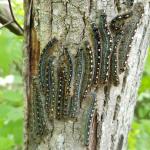 Forest Tent Caterpillar: Malacosoma disstria egg hatch occurs between 192-363 GDD’s (base 50°F) by mid-late May and caterpillars may be active for at least 5-6 weeks following. Susceptible hosts whose leaves are fed on by this insect include oak, birch, ash, maple, elm, poplar, and basswood. This native insect has many natural enemies, including some very effective pathogens that typically regulate populations. However, outbreaks of this insect can occur on occasion.
Forest Tent Caterpillar: Malacosoma disstria egg hatch occurs between 192-363 GDD’s (base 50°F) by mid-late May and caterpillars may be active for at least 5-6 weeks following. Susceptible hosts whose leaves are fed on by this insect include oak, birch, ash, maple, elm, poplar, and basswood. This native insect has many natural enemies, including some very effective pathogens that typically regulate populations. However, outbreaks of this insect can occur on occasion.- Hemlock Looper: Two species of geometrid moths in the genus Lambdina are native insects capable of defoliating eastern hemlock, balsam fir, and white spruce. Adult moths lay their eggs on the trunk and limbs of hosts in September and October, and eggs hatch by late May or early June (L. fiscellaria caterpillars may be active between 448-707 GDD’s). Monitor susceptible hosts for small, inch-worm like caterpillars. Where populations are low, no management is necessary. Hemlock loopers have several effective natural enemies.
- Honeylocust Plant Bug: Diaphnocoris chlorionis feeding results in tiny yellowish-brownish spots on leaves, leaf distortion, and in some cases, defoliation. (There are at least 7 species of plant bugs that feed on honeylocust, Gleditsia triacanthos.) There is one generation per year. Immatures and adults feed on foliage and light to moderately damaged foliage may persist throughout the growing season. Honeylocust plant bugs overwinter as eggs laid just beneath the bark surface of 2 and 3 year old twigs. Eggs hatch just after vegetative buds of the host begin to open. Young nymphs crawl to the opening leaflets and begin feeding; the most significant damage occurs at that time, when the insect is hidden from view. Nymphs develop into adults around May-July. This insect can be targeted between 58-246 GDD’s (base 50°F).
- Hydrangea Leaftier: Olethreutes ferriferana is a moth in the Family Tortricidae whose caterpillars use silk applied to the edges of two newly expanding hydrangea leaves to tie them together to create an envelope-like structure within which they feed. These leaf-envelopes tend to occur near the tips of plant stems and can be very obvious. As a result, the two tied leaves may not fully expand when compared to healthy, non-impacted leaves. Many envelope or purse-like structures can be seen throughout the plants and may be found from the base to the top of the plant. By gently pulling apart the tied-together leaves, tiny caterpillars are revealed within and can be mechanically managed by crushing the individual caterpillars. Caterpillars are green and partially transparent with a black head capsule and a black thoracic shield which is found on the top of the body segment located directly behind the head. Pupation occurs sometime in June and is thought to occur in the ground near by host plants, so the insect drops to the ground to pupate where it overwinters. Adults are found in the spring and are small white and brown moths. Eggs are laid on branch tips of various species of hydrangea. Only one generation is known per year. This insect, although creating visible and interesting damage to hydrangea, is not usually considered to be a serious pest, although occasional localized problematic populations have been reported. Removing leaf-envelopes in the early spring or pinching them to kill the caterpillar within can help reduce populations on individual plants.
 Imported Willow Leaf Beetle: Plagiodera versicolora adult beetles overwinter near susceptible hosts. Adult beetles chew holes and notches in the leaves of willow once they become available. Females lay yellow eggs in clusters on the undersides of leaves. Larvae are slug-like and bluish-green in color. They feed in clusters and skeletonize the leaves. Most plants can tolerate the feeding from this insect, and foliage will appear brown. Repeated yearly feeding can be an issue, in which case management of the young larvae may be necessary. Take care with treatment in areas near water. Check out Episode 4 of InsectXaminer to see the imported willow leaf beetle in action.
Imported Willow Leaf Beetle: Plagiodera versicolora adult beetles overwinter near susceptible hosts. Adult beetles chew holes and notches in the leaves of willow once they become available. Females lay yellow eggs in clusters on the undersides of leaves. Larvae are slug-like and bluish-green in color. They feed in clusters and skeletonize the leaves. Most plants can tolerate the feeding from this insect, and foliage will appear brown. Repeated yearly feeding can be an issue, in which case management of the young larvae may be necessary. Take care with treatment in areas near water. Check out Episode 4 of InsectXaminer to see the imported willow leaf beetle in action.- Lecanium Scales (Oak): Parthenolecanium quercifex overwinters as a second instar nymph on oak twigs. Females begin feeding and mature in the spring from mid-April to early May; eggs may be laid between late May and into June. Eggs hatch in June or early July and crawlers migrate to host plant leaves where they spend the summer and migrate as second instars back to host plant twigs in the fall.
- Lilac Borer: Podosesia syringae is a clearwing moth pest of lilac, privet, fringetree, and ash. (It is also known as the ash borer, not to be confused with the emerald ash borer.) Adults mimic paper wasps. Larvae are wood-boring, and signs and symptoms include branch dieback, holes, and occasionally, sawdust-like frass accumulated on bark. Larvae bore into stems, trunks, and branches, chewing an irregularly shaped entrance hole. Peak adult moth flights may occur in the northern portion of this insect’s range in June and is usually over by August 1st. Pheromone traps can be used to time adult emergence. Adult females lay flattened, oval, and tan eggs that are deposited singly or in clusters on bark crevices, ridges, and sometimes smooth bark; but usually laid in or near wounds in the bark. On average, 395 eggs are laid by each female. After hatch, larvae chew into the bark and feed laterally and then vertically in phloem tissue. Larvae overwinter in tunnels in the final instar and resume feeding in the spring. Adults emerge through a round exit hole (4-5 mm in diameter). This insect may be targeted between 200-299 GDD’s (base 50°F).
 Lily Leaf Beetle: Lilioceris liliiadults overwinter in sheltered places. As soon as susceptible hosts such as Lilium spp. (Turk’s cap, tiger, Easter, Asiatic, and Oriental lilies) and Fritillaria spp. break through the ground, the adult lily leaf beetles are known to feed on the new foliage. (Note: daylilies are not hosts.) Adult lily leaf beetles were observed to be active in Hanson, MA on 4/14/2023. Typically, mating occurs in May and each female begins to lay 250-450 eggs in neat rows on the underside of the foliage. If there are only a few plants in the garden, hand picking and destroying overwintering adults can help reduce local garden-level populations at that time. Check out Episode 3 of InsectXaminer to see the lily leaf beetle in action.
Lily Leaf Beetle: Lilioceris liliiadults overwinter in sheltered places. As soon as susceptible hosts such as Lilium spp. (Turk’s cap, tiger, Easter, Asiatic, and Oriental lilies) and Fritillaria spp. break through the ground, the adult lily leaf beetles are known to feed on the new foliage. (Note: daylilies are not hosts.) Adult lily leaf beetles were observed to be active in Hanson, MA on 4/14/2023. Typically, mating occurs in May and each female begins to lay 250-450 eggs in neat rows on the underside of the foliage. If there are only a few plants in the garden, hand picking and destroying overwintering adults can help reduce local garden-level populations at that time. Check out Episode 3 of InsectXaminer to see the lily leaf beetle in action.- Magnolia Scale: Neolecanium cornuparvum overwinters as first instar nymphs which are elliptical, dark slate gray in color, and can usually be found on the undersides of 1 and 2 year old twigs. Nymphs may molt by late April or May and again by early June, at which time the scales may be purple in color. Eventually nymphs secrete a white powdery layer of wax over their bodies.
- Oak Apple Galls: Several species of gall wasps cause structures referred to as oak apple galls. A common species mentioned in Johnson and Lyon (1991) is Amphibolips confluenta, which forms large galls that are attached to the midrib or petiole of oak leaves. Additional species in this genus are known to cause oak apple galls, including A. quercusinanis and A. quercusspongifica. A. confluenta galls are filled with a spongy mass that may be cut with a knife. A single wasp larva is found within a hard, seed-like cell in the center of the gall. As the gall dries, the spongy interior becomes a mass of fibers radiating from this central cell to the thin shell of the gall. These galls do no damage to their host plants and do not require management. Not enough is known about gall forming insects, and there is so much to learn!
-
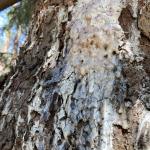 Pitch Mass Borer: Synanthedon pini is a native clearwing moth whose larvae feed within various pines and spruce. Feeding by the larvae (caterpillars) of this insect causes pitch masses to form on host plants. Two or three years are required for this insect to complete its life cycle, with adult moths present during the summer. Adult pitch mass borer moths may resemble wasps. Adult males and females are blue/black from above, marked with a patch of red/orange on the underside of the abdomen, with some orange on the top of the fourth abdominal segment. Orange is also found along the sides of the abdomen. Forewings are black/blue in color and opaque with wing length of 0.47 to 0.59 inches. Adults are said to emerge, mate, and females lay eggs on their hosts sometime in July. By the late summer, the larvae (immatures; caterpillars) bore into their host plant, tunneling through the trunks, often directly beneath a branch. Larvae have uniformly dark brown heads, white bodies, and prolegs with rows of 6-8 crochets on the bottom of their "feet". At the site of the borer wound, large amounts of pitch exude from the tree in a hemispherical mass above the larval tunnels. Larvae continue to feed and develop in the tree through the following year and it is thought that these caterpillars may take up to two years to mature. Masses may be 3-4 inches in diameter. Pupation occurs in a subsequent end of May through June in time for adult emergence by July and August. Pupal cells are formed within the pitch mass and lined with silk (Beuttenmüller, 1901). Pupae are 3/4 inch long and light brown in color (Kellicott, 1881).
Pitch Mass Borer: Synanthedon pini is a native clearwing moth whose larvae feed within various pines and spruce. Feeding by the larvae (caterpillars) of this insect causes pitch masses to form on host plants. Two or three years are required for this insect to complete its life cycle, with adult moths present during the summer. Adult pitch mass borer moths may resemble wasps. Adult males and females are blue/black from above, marked with a patch of red/orange on the underside of the abdomen, with some orange on the top of the fourth abdominal segment. Orange is also found along the sides of the abdomen. Forewings are black/blue in color and opaque with wing length of 0.47 to 0.59 inches. Adults are said to emerge, mate, and females lay eggs on their hosts sometime in July. By the late summer, the larvae (immatures; caterpillars) bore into their host plant, tunneling through the trunks, often directly beneath a branch. Larvae have uniformly dark brown heads, white bodies, and prolegs with rows of 6-8 crochets on the bottom of their "feet". At the site of the borer wound, large amounts of pitch exude from the tree in a hemispherical mass above the larval tunnels. Larvae continue to feed and develop in the tree through the following year and it is thought that these caterpillars may take up to two years to mature. Masses may be 3-4 inches in diameter. Pupation occurs in a subsequent end of May through June in time for adult emergence by July and August. Pupal cells are formed within the pitch mass and lined with silk (Beuttenmüller, 1901). Pupae are 3/4 inch long and light brown in color (Kellicott, 1881).Adult moths are active during the summer. Following egg laying and egg hatch, the larvae tunnel under the bark to the cambium. Obvious large globs of pitch appear on trunks. Occurs sporadically on individual trees. Host trees with active caterpillars have pitch masses that may appear coated in a white, powdery substance. Larvae may also preferentially bore into the host beneath a broken branch or scar. This insect will attack large trees, up to 30-40 feet from the ground. Healthy trees are also preferentially utilized. Overall damage to the health of the host tree is typically not extensive, and therefore chemical management of this insect is often unnecessary.
Pitch can be removed and the single larva within destroyed. Physical/mechanical management of this insect, if it can be safely done, is a great way to manage the pitch mass borer on individual specimen trees. The act of just pulling the caterpillar from its pitch mass will kill it - much to the frustration of history's entomologists looking to study them - as soon as contact of the pitch is made with the caterpillar's body and hardens and adheres to them. Parasitism by natural enemies is reported to be relatively common. Parasitic wasps in the family Eulophidae are noted but not specified, as well as a caterpillar-eating species of fly (Engelhardt, 1946).
- Rhododendron Borer: Synanthedon rhododendri is one of the smallest of the native clearwing moths. Rhododendrons are preferred hosts, although mountain laurel and deciduous azaleas can be heavily infested, especially if they are planted in close proximity to rhododendrons. Injury may be first noticed in the fall (leaves lose their sheen, then become pale green, then olive, then chlorotic) and can look similar to drought stress. On branches that seem to be stunted, look at limb crotches, scars, and other irregularities for sawdust stuck on bark or on the ground beneath these areas. In late May and early June, holes may contain pupal shed skins extending halfway out. Moth emergence occurs in the late-spring, early-summer. After mating, female moths seek out suitable egg laying locations (preferring wounded areas or limb crotches). The female lays her eggs and dies. Eggs hatch and larvae tunnel into the inner bark where they feed in tunnels that become packed with reddish frass pellets. By late fall, larvae move to the sapwood where they overwinter and resume feeding by mid-March. Pupation occurs in the spring and there is one generation per year. Prune out and destroy infested branches before late May/June. Monitor for adults in mid-May (192-298 GDD’s, base 50°F).
-
Roseslugs: Two species of sawfly can be found on the leaves of roses at this time. These small, caterpillar-like larvae skeletonize the upper leaf surface and leave a “window-pane” like pattern behind. When present in large numbers, these insects are capable of defoliating their entire host. Caterpillars may feed until roughly mid-June, at which time they pupate. Management options include an insecticidal soap spray or a product containing spinosad.
- Snowball Aphid: Neoceruraphis viburnicola eggs overwinter on viburnum twigs and buds. Eggs hatch and this aphid becomes active on certain species of viburnum roughly between 148-298 GDD’s or around redbud bloom. This insect is particularly noticeable on V. opulus, V. prunifolium, and V. acerifolia. Stem mothers, appearing blueish-white, can be found in curled up and distorted foliage. Damage caused by this insect pest is mostly aesthetic.
- Spruce Bud Scale: Physokermes piceae is a pest of Alberta and Norway spruce, among others. Immatures overwinter on the undersides of spruce needles, dormant until late March. Immatures overwinter on the undersides of spruce needles, remaining dormant until late March. By April, females may move to twigs to complete the rest of their development. Mature scales are reddish brown, globular, 1/10 inch in diameter, and found in clusters of 3-8 at the base of new twig growth. They closely resemble buds and are often overlooked. Crawlers are present around June.
- Spruce Spider Mite: Oligonychus ununguisis a cool-season mite that becomes active in the spring from tiny eggs that have overwintered on host plants. Hosts include spruce, arborvitae, juniper, hemlock, pine, Douglas-fir, and occasionally other conifers. This particular species becomes active in the spring and can feed, develop, and reproduce through roughly June. When hot, dry summer conditions begin, this spider mite will enter a summer-time dormant period (aestivation) until cooler temperatures return in the fall. This particular mite may prefer older needles to newer ones for food. Magnification is required to view spruce spider mite eggs. Tapping host plant branches over white paper may be a useful tool when scouting for spider mite presence (view with a hand lens). Spider mite damage may appear on host plant needles as yellow stippling and occasionally fine silk webbing is visible.
- Taxus Mealybug: Dysmicoccus wistariae produces honeydew which leads to sooty mold growth, yellowing of needles, and sparsely foliated plants. Eventual dieback may be possible. This species is commonly associated with Taxus in New England, but can be occasionally found on dogwood, rhododendron, Prunus spp., maple, andromeda, and crabapple. These mealybugs are found on stems and branches and particularly like to congregate at branch crotches. Taxus mealybug feeds in the inner bark tissue of the trunk and branches. Adult females are present from June to August and give birth to living young in the summer. Immatures overwinter. A single generation may occur per year in New England, but areas to the south can have multiple generations of this insect. Management may be targeted between 246-618 GDD’s (base 50°F). Horticultural oil and neem oil may be used.
- Viburnum Leaf Beetle: Pyrrhalta viburni is a beetle in the family Chrysomelidae that is native to Europe, but was found in Massachusetts in 2004. By 2008, viburnum leaf beetle was considered to be present in all of Massachusetts. Larvae are present and feeding on plants from approximately late April to early May until they pupate sometime in June. Adult beetles emerge from pupation by approximately mid-July and also feed on host plant leaves, mate, and lay eggs at the ends of host plant twigs where they overwinter. This beetle feeds exclusively on many different species of viburnum, which includes, but is not limited to, susceptible plants such as V. dentatum, V. nudum, V. opulus, V. propinquum, and V. rafinesquianum. Some viburnum have been observed to have varying levels of resistance to this insect, including but not limited to V. bodnantense, V. carlesii, V. davidii, V. plicatum, V. rhytidophyllum, V. setigerum, and V. sieboldii. More information about viburnum leaf beetle may be found at http://www.hort.cornell.edu/vlb/ and at https://ag.umass.edu/landscape/fact-sheets/viburnum-leaf-beetle.
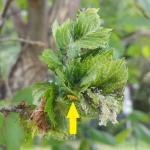 Woolly Apple Aphid: Eriosoma lanigerum may be found on apple, crabapple, hawthorn, mountain ash, Pyracantha, and elm hosts. The primary (winter) host is elm, on which aphids infest emerging spring leaves, causing leaves to curl or close into stunted, rosette-like clusters found at twig tips. On apple and crabapple, this species of aphid colonizes roots, trunks, and branches in the summer and is commonly found near previous wounds or callous tissue. On roots, the aphids cause swelled areas which can girdle and kill roots. The aphids, when found in above ground plant parts such as elm leaves, are covered with white wax. Eggs are the overwintering stage on elm, which hatch in the spring in time for the nymphs to infest new elm foliage. Following a few generations on elm, the aphids will develop into a winged form, which disperse and seek out apple and crabapple. Multiple generations will occur on these alternate hosts in the summer and by the fall, a winged form will return to elm and mated females lay eggs near elm buds. These aphids are a favorite snack for insect predators such as the multicolored Asian lady beetle, Harmonia axyridis.
Woolly Apple Aphid: Eriosoma lanigerum may be found on apple, crabapple, hawthorn, mountain ash, Pyracantha, and elm hosts. The primary (winter) host is elm, on which aphids infest emerging spring leaves, causing leaves to curl or close into stunted, rosette-like clusters found at twig tips. On apple and crabapple, this species of aphid colonizes roots, trunks, and branches in the summer and is commonly found near previous wounds or callous tissue. On roots, the aphids cause swelled areas which can girdle and kill roots. The aphids, when found in above ground plant parts such as elm leaves, are covered with white wax. Eggs are the overwintering stage on elm, which hatch in the spring in time for the nymphs to infest new elm foliage. Following a few generations on elm, the aphids will develop into a winged form, which disperse and seek out apple and crabapple. Multiple generations will occur on these alternate hosts in the summer and by the fall, a winged form will return to elm and mated females lay eggs near elm buds. These aphids are a favorite snack for insect predators such as the multicolored Asian lady beetle, Harmonia axyridis.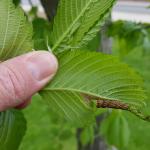 Woolly Elm Aphid: Eriosoma americanum females lay a single egg in the cracks and crevices of elm bark, where the egg overwinters. Eggs hatch on elm in the spring as leaves are unfolding. Aphids may be active from 121-246 GDD’s (base 50°F) on elm. A young, wingless female hatched from the egg feeds on the underside of leaf tissue. This female aphid matures and gives birth to 200 young, all females, without mating. These aphids feed and the elm leaf curls around them and protects them. By the end of June, winged migrants mature and find serviceberry hosts, where another set of females is produced. These new females crawl to and begin feeding on the roots of serviceberry. Multiple generations occur on the roots of serviceberry through the summer.
Woolly Elm Aphid: Eriosoma americanum females lay a single egg in the cracks and crevices of elm bark, where the egg overwinters. Eggs hatch on elm in the spring as leaves are unfolding. Aphids may be active from 121-246 GDD’s (base 50°F) on elm. A young, wingless female hatched from the egg feeds on the underside of leaf tissue. This female aphid matures and gives birth to 200 young, all females, without mating. These aphids feed and the elm leaf curls around them and protects them. By the end of June, winged migrants mature and find serviceberry hosts, where another set of females is produced. These new females crawl to and begin feeding on the roots of serviceberry. Multiple generations occur on the roots of serviceberry through the summer.- Yellow Poplar Weevil: Odontopus calceatus is also known as the sassafras weevil, the magnolia leafminer, or the tulip tree leafminer. This insect, as all of these common names suggest, feeds on yellow poplar (tulip tree; Liriodendron tulipifera), sassafras (Sassafras albidum), magnolia (Magnolia spp.), as well as bay laurel (Laurus nobilis). This insect is native to much of the eastern US. Both the larvae and the adults of the yellow poplar weevil feed on its hosts. Adults feed on the leaves and buds while the larvae mine the leaves. Adult feeding causes irregular holes to form in the leaves. Yellow poplar weevils overwinter as adults in sheltered areas, such as the leaf litter, around their hosts. In the early spring, they initiate feeding on the buds and newly opening leaves of the host plant. By May, they lay eggs in the midrib of the leaves on leaf undersides. Eggs hatch and the larvae mine the leaves, creating blotch-like mines. This mining begins at the tip (point) of the leaf on tulip tree and Magnolia grandiflora hosts. Yellow poplar weevil larvae are white, legless, and approximately 2 mm long. Up to 9 larvae have been recorded in a single blotch mine. Larvae are mostly observed in late May and June. Pupation occurs in the leaf mines and adults of the new generation emerge to feed on leaves. Adults have been observed feeding as late as August in the southern portions of its range in the US (ex. Mississippi). Adult weevils may seek indoor shelters such as homes for overwintering protection. Feeding damage from this insect is not often reported as of economic importance, however in the southern parts of its range, outbreaks have occasionally occurred (Johnson and Lyon, 1991). Natural enemies of the yellow poplar weevil have been reported, particularly hymenopteran parasitoids. Five species (Heterolaccus hunteri, Habrocytus piercei, Horismenus fraternus, Zagrammosoma multilineatum, and Scambus hispae) have been reported to kill 50% of yellow poplar weevil pupae (Burns and Gibson, 1968).
Concerned that you may have found an invasive insect or suspicious damage caused by one? Need to report a pest sighting? If so, please visit the Massachusetts Introduced Pests Outreach Project: http://massnrc.org/pests/pestreports.htm.
Reported by Tawny Simisky, Extension Entomologist, UMass Extension Landscape, Nursery, & Urban Forestry Program
Additional Resources
Pesticide License Exams - The MA Dept. of Agricultural Resources (MDAR) is now holding exams online. For more information and how to register, go to: https://www.mass.gov/pesticide-examination-and-licensing.
To receive immediate notification when the next Landscape Message update is posted, join our e-mail list or follow us on Facebook.
For a complete listing of landscape, nursery, and urban forestry program upcoming events, see our calendar at https://ag.umass.edu/landscape/upcoming-events.
For commercial growers of greenhouse crops and flowers - Check out UMass Extension's Greenhouse Update website.
For professional turf managers - Check out Turf Management Updates.
For home gardeners and garden retailers - Check out our home lawn and garden resources.
Diagnostic Services
UMass Laboratory Diagnoses Landscape and Turf Problems - The UMass Extension Plant Diagnostic Lab is available to serve commercial landscape contractors, turf managers, arborists, nurseries and other green industry professionals. It provides woody plant and turf disease analysis, woody plant and turf insect identification, turfgrass identification, weed identification, and offers a report of pest management strategies that are research based, economically sound and environmentally appropriate for the situation. Accurate diagnosis for a turf or landscape problem can often eliminate or reduce the need for pesticide use. For sampling procedures, detailed submission instructions and a list of fees, see the Plant Diagnostic Laboratory web site.
Soil and Plant Nutrient Testing - The University of Massachusetts Soil and Plant Nutrient Testing Laboratory is located on the campus of The University of Massachusetts at Amherst. Testing services are available to all. The lab provides test results and recommendations that lead to the wise and economical use of soils and soil amendments. For more information, including current turn-around times, visit the UMass Soil and Plant Nutrient Testing Laboratory web site. The lab is currently accepting new orders for Routine Soil Analysis (including optional Organic Matter, Soluble Salts, and Nitrate testing), Particle Size Analysis, Pre-Sidedress Nitrate (PSNT), Total Sorbed Metals, and Soilless Media (no other types of soil analyses available at this time). Check for current turnaround time. Please plan for the fact that date of receipt in the lab is affected by weekends, holidays, shipping time, and time for UMass Campus Mail to deliver samples to the lab.
Tick Testing - The UMass Center for Agriculture, Food, and the Environment provides a list of potential tick identification and testing options at: https://ag.umass.edu/resources/tick-testing-resources.
Acknowledgements: UMass Extension gratefully acknowledges the support of the following funding sources for the production of the Landscape Message –
- The Massachusetts Nursery and Landscape Association Fund
- The Massachusetts Department of Conservation and Recreation, Award #ISADCR28219926UMA22A
- Stakeholders like you! The Landscape Message is partially supported by educational program user fees.
